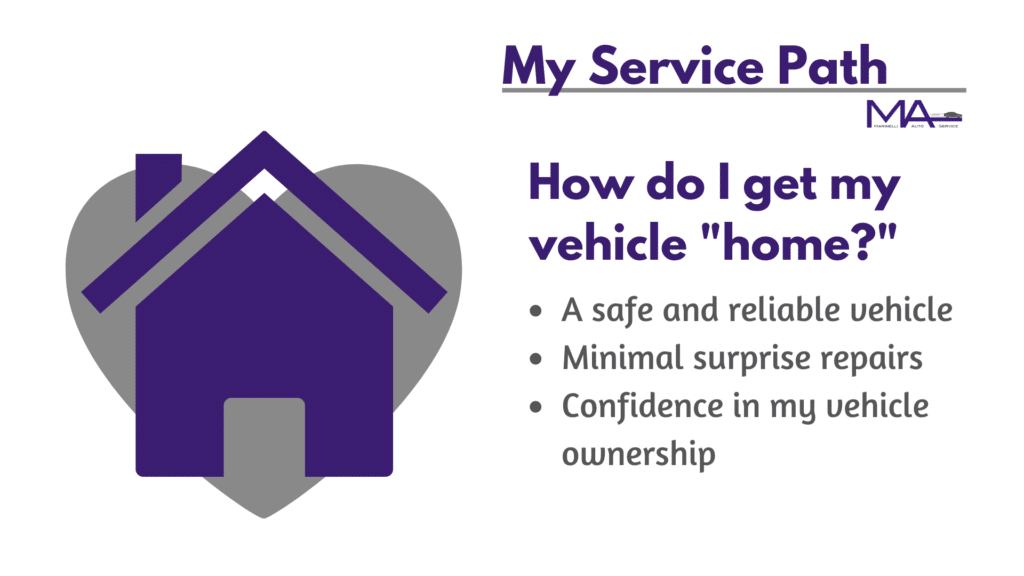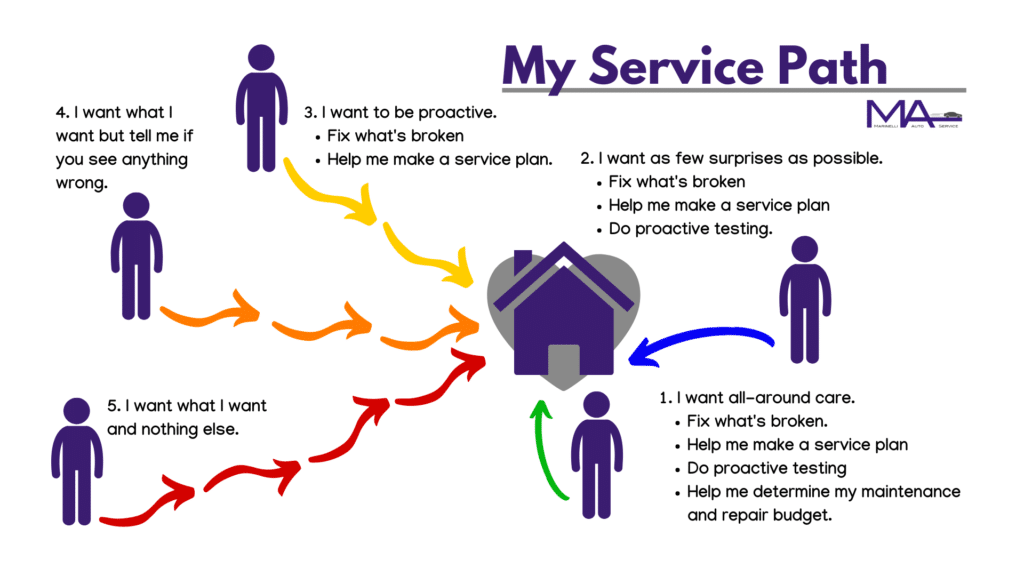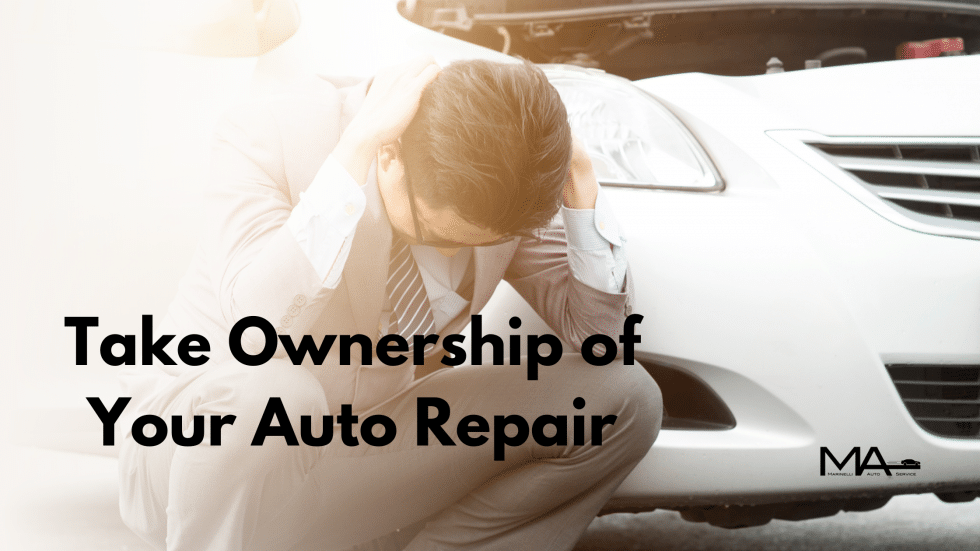It’s common to be uneasy about having your vehicle serviced. Shop practices vary widely so it’s hard to know what to expect. Not surprisingly, many people have their guard up.
With too many negative experiences you can lose hope. Maybe you expect “the list” or pressure tactics. Maybe you assume that no-one will look out for you so you must look out for yourself.
Maybe you’d be relieved just to find a shop that will find and fix the problem the first time, charge fairly, and treat you well.
We all use our past experiences and current desires to decide what paths we take toward a solution. This includes auto service. Automotive service paths can be short and effective or long, winding, and tiresome. Whether it’s home sweet home, feeling at home at work, or feeling at home with another person, there’s always a path that got you “home”.


How long will your path be?
To illustrate, let’s pretend that each owner has the same kind of vehicle with the same mileage and the same concerns.
Here are their journeys over the course of one year.
5. I want what I want and nothing else.
Visit #1
John tells the shop that he wants an alignment done because he thinks it will resolve the vehicle’s shaking. He rebuffs the shop’s questions about why he wants the alignment done and has no interest in any prior evaluation.
He gets the alignment but not the result that he wanted. His car is still shaking just as badly as it was before.
Visit #2
At this point, John may question the quality of the alignment or he may try another shop.
This time, he clearly articulates that he wants the shake to go away, and it is resolved by tire balancing. When the shop inquires about inspecting the vehicle for proactive maintenance and repairs, he declines. They notice the leaking strut, but John isn’t concerned about it.
Visits #3
John is back at the shop because the weak battery failed to start the car. He refuses testing for coolant leakage after the coolant reservoir is found empty.
Visit #4
John’s vehicle is back for overheating. It turns out the reservoir went empty due to radiator leakage.
Visit #5
In visit 5, John’s vehicle is back in the shop for a suspension noise. It gets traced to that leaking strut.
However, the mechanic notices that the right front tire is bald on the inside due to a failing steering rod. An alignment is part of the repair procedure. Now John is particularly unhappy. He paid for an alignment six months ago so why does his tire look like this? The alignment didn’t hold because of the loose steering tie rod.
John pays for another tire, replacement of the steering tie rod, and second alignment.
It has now taken five visits and several repairs, including two alignments and an extra tire for John to get his vehicle “home.” And John? He doesn’t feel at home at all.
Maybe he’s gone to the same shop for everything and thinks that their recommendations are inconsistent or inadequate. Maybe he’s moving from shop to shop in pursuit of what he wants. Regardless, he’s not having a pleasant experience.
The “I want what I want and nothing else” mindset will often result in a long path to get your vehicle home. You personally may never feel “at home” yourself.
4. I want what I want but tell me if you see anything wrong.
Visit #1
Susan is fairly confident her car needs an alignment because it’s shaking. She’s been overcharged and treated unfairly in the past so she arrives with a desire to control the process. However, she realizes that she doesn’t know everything her vehicle might need. She’s ok with some extra information as long as it’s free.
To Susan’s credit, when the shop asks her why she wants an alignment done, she mentions the shake concern. They advise that the alignment is not a primary suspect, and after some good wheel balancing, her shake concern is resolved.
The shop also notices the leaking strut and she doesn’t take offense to hearing this, but she’s not that concerned about it because the car still feels ok to her. They recommend an inspection but she thinks, “Last time I approved an inspection like that another shop tried to sell me unnecessary work and the car has felt fine since then.”
Visit #2
Just like John, Susan is back because of a failed battery. However, she also decides to have the missing coolant evaluated. This saves her from the vehicle coming back overheating, but after declining an inspection, she remains unaware of the loose tie rod.
Visit #3
Susan is back for an oil change, and the mechanic finds her right front tire bald on the inside. Susan is ok with a new tire and an alignment but still declines an inspection. The loose tie rod remains.
Visit #4
Like John, Susan returns for the suspension noise that will be pinned to the strut. However, the right front tire is wearing out unevenly again, and now the loose tie rod, the root cause, is finally found. The tie rod is replaced, but one more alignment and another tire are needed as well.
It has taken four visits, an extra tire, and an extra alignment for Susan to get her vehicle home.
How is Susan doing? She acknowledges that the recommendation to inspect the vehicle before the first alignment was legitimate. However, she wonders, “Why were they willing to take my money if they weren’t confident that the alignment would hold?”
Susan is feeling better than John is, but the repeated visits to the shop have worn on her too. She feels apprehensive that even in an honest shop, surprises could still come.
3. I want to be proactive.
Brian liked his shop’s reliable repair results and their informative, low-pressure communication. When asked about pursuing a proactive approach to vehicle service, he agreed. This sounded better than waiting for things to wear out, surprise him, or strand him. Brian learned that proactive inspections and checks could help him budget time and money and avoid surprises.
Brian also talked with his shop about maintenance. He learned that periodic tire rotations and balancing would help extend tire tread life and ride quality and protect vehicle chassis components from excessive vibration. He came to expect rotations and balance checks (when due) with oil changes. Good tire balance work eliminated that vibration before he ever noticed it.
Visit #1
Brian requests an oil change, tire rotation and balance, and inspection. The inspection reveals the missing coolant, the loose tie rod, the leaking strut, and the weak battery. Brian addresses the coolant leakage right away and thus his car never overheats. He addresses the battery right away and avoids the no start. For budgeting reasons, he decides to address the remaining items at his next visit.
Visit #2
In this visit, Brian has his oil changed and addresses the rest of the concerns. He leaves with full confidence in his vehicle. He’s in a good place even though that loose tie rod cost him a tire due to uneven wear (just like John and Susan.) This gets Brian thinking about how much car fund money to save so that he won’t have to wait for a repari next time.
Brian’s trust in his car is growing, his relationship with his shop is growing, and after two visits that year he’s already home.
2. I want as few surprises as possible.
Christine never experiences a vibration. Much like Brian, accrued trust between her and the shop and helpful conversation leads toward cost-effective maintenance and proactive inspections.
Visit #1
Like Brian, she has her oil changed, tires balanced and rotated, and an inspection done.
Christine also has a budget to consider and is unsure about addressing the tie rod concern right away. The budget is more comfortable for her to address the coolant loss and battery now and to wait on the tie rod. So, she asks an intelligent and informed question: “What happens if I wait on these things?” Once she hears that the loose tie rod can affect the alignment and allow abnormal tire wear, she decides not to wait.
She gets everything done now but thinks, “How much should I be putting into a car fund so I don’t have to pull it from elsewhere?”
Visit #2
Christine is intrigued by the idea of not only catching current concerns but also preventing break-downs. Is this possible? The shop explains that proactive or predicting testing can be done for some components that are most likely to cause an unexpected break-down. The starter, alternator, and fuel pump, for example.
Her next visit includes an oil change and proactive testing. After this testing shows that the starter motor contacts are getting scorched, Christine has the engine starter replaced. This replaces a degrading component and saves her from the starting problems that were coming in the next year.
With two visits that year, Christine gets home and avoids a future problem that she would otherwise have had no way to predict. The only pain point during this process was the budgeting decision.
Within two visits, including oil changes, Christine gets home.
She trusts the information she’s been given; she was supported in making confident decisions, and she’s fully confident in her car. Unlike the others, it did not cost her an extra tire.
1. I want all around care.
Justin and Caroline are a married couple whose experiences mirror those of Brian and Christine. The vibration never affects them. They get what they need from inspections and plan repairs accordingly. They feel at home with both their vehicles and their shop.
However, while Brian and Christine both experienced some stress when it came to budgeting and timing of repairs, Justin and Caroline do not. Brian and Christine left happy and at peace, but they also left wondering how much money they should be putting into their car funds.
Justin and Caroline’s shop did a cost analysis of their repair history. This illuminates what they have spent in servicing their vehicles. Averaging those service and maintenance expenses per month both shows them that they are far under the cost of a car payment and helps them to know how much money to put aside. Should Justin and Caroline ever wonder if one of their vehicles is worth a large repair, that cost analysis will help them make an informed decision.
Justin and Caroline enjoy confidence in the safety and reliability of their vehicles and in their shop’s communication and quality of work. They also enjoy the confidence of budgeting effectively for continued vehicle care. They are glad to have found a shop that both listens and communicates informatively.
Home
Getting “home” with your vehicle looks different for everyone. Until you have a confident trusting relationship with your shop, you may find yourself taking a longer path. We hope you are able to build that relationship and get home in as few visits as possible.
No matter whether you are well off financially or must watch every penny, you should always be treated with kindness and respect. If money is tight, how much more important is it that every dollar spent is spent well? Value saves money and time over the long haul.
Marinelli Auto Service is an auto repair shop in Winter Park, Florida. We’ve been serving Central Florida since 2015. We provide maintenance and repairs for a variety of makes and models.
